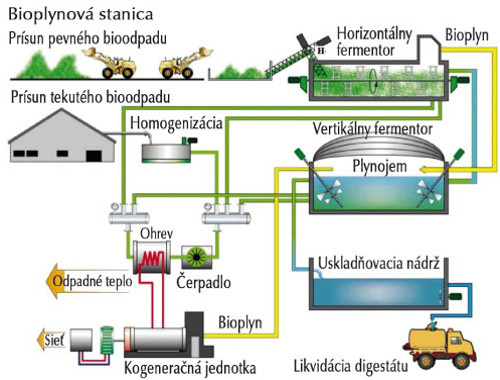Production and use of biogas
Anaerobic fermentation (anaerobic digestion or methane fermentation) is a biochemical conversion of biomass while the biogas is released. The fermentation takes place in airtight tank of the biogas plant (fermenter) where the biomass is heated up to the operating temperature for specific period of time (usually experimentally validated). The biomass without oxygen is decomposed by the action of methanogenic bacterias at temerature from 5 to 60 ° C to produce biogas and liquid or mashed digestate. For fermentation the mesophilic zone is mostly used.

Fermentation and biogas production
The fermentation usually takes place the large digestion tanks - fermenter - and it consists of four phases.
Hydrolysis
This takes place while still in the environment that contains residual air oxygen. Organic polymers (polysaccharides, lipids, proteins) with the help of anaerobic bacterias decompose into monomers - alcohols and fatty acids, releasing hydrogen (H2) and carbon dioxide (CO2).
Acidogenesis
Reaction when residue oxygen is used creating anaerobic environment and volatile fatty acids. This transformation is performed facultatively anaerobic microorganisms that are capable of existing in both environments.
Acetogenesis
Acidogenic bacterias convert volatile organic acids and alcohol into the acetic acid, H2 and CO2.
Metanogenesys
It is the last stage of decomposition process in which methanogenic bacterias in an environment without air convert acetic acid to methane (CH4) and CO2 and hydrogentrofic bacterias produce methane from CO2 and H2.